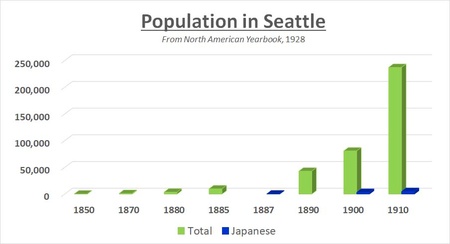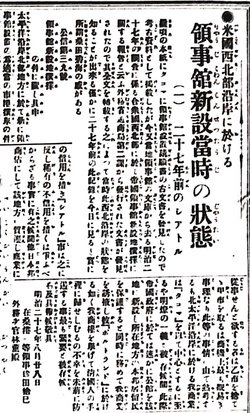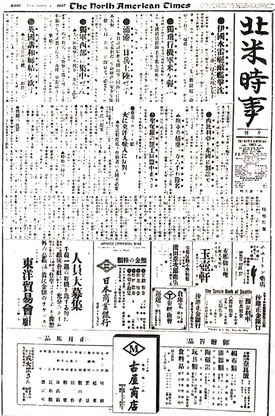The North American Times is a Japanese newspaper that was published in Seattle from 1902 until shortly after the United States’ entry into World War II. A microfilm archive is kept at the University of Washington (UW) Library. Scott Edward Harrison was a librarian at the East Asian Library, UW. In 2004, he researched the newspaper and archived what is available of it. From June 2019 to May 2020, the author serialized “Yoemon Shinmasu – My Grandfather’s Life in Seattle” in both English and Japanese on Discover Nikkei and the North American Post, the successor to the North American Times. He discovered that the latter’s archives can be viewed on the UW Libraries website and started reading them online.
The archives contain only the issues from December 1917 to March 1920, July to August 1934, November to December 1934, October 1935, and November 1937 to March 1940. Although the available issues are limited, the amount of information therein is enormous. According to the North American Post editorial department, many papers have been lost due to censorship during the Pacific War and the detention of Japanese Americans.
On the first page of the oldest archive, which is the December 14, 1917 issue, there are many advertisements for Japanese shops, restaurants, banks, etc. There is also an advertisement for Furuya Shoten, which was one of the biggest Japanese stores in Seattle at that time. Year-end gifts and New Year’s items are widely posted and items reminiscent of Japan, such as silk cloth, lacquerware, ceramics, “narazuke” (pickles), “kazunoko” (herring roe), and “konbu” (kelp) are advertised. Most of the articles are about the Japanese homeland, its international situation, and news related to Japan. For Japanese living in foreign countries, it seems as though what they were most interested in was news about their home country.
In reading the rest of the newspaper, I found articles on page 5 about the Japanese community in Seattle. Various topics are posted such as travel (especially to and from Seattle), “Nihonjinkai” (Japanese associations), “Kenjinkai” (prefectural associations), grocery stores, business associations (such as those of grocery stores, barber shops, and hotels), Japanese language schools, civic groups, cultural circles, sports, etc. It is clear that the North American Times played an important role as a hub of Japanese language information at that time. The articles clearly show the issues that Japanese immigrants faced and their activities at that time. I was able to trace the history of Japanese immigrants in Seattle in various phases, from the beginning of Japanese immigration, to the Issei starting to successfully establish their lives, to picture brides coming to the country. Nisei children faced issues of education, dual citizenship, and marriage, and the U.S.-Japan relationship began to deteriorate after the Sino-Japanese War began.
I aim to unravel the history of Japanese American immigrants in Seattle by presenting articles from the North American Times related to the above. In this first chapter, I will introduce an article that tells how Seattle, a quiet fishing village, blossomed into a big city. Excerpts from the North American Times are summaries of the original text.
Seattle, the Deserted Village
“Seattle 59 years ago - a reminiscence of Mrs. Uden, a Seattle pioneer lady,” was serialized in the issues of July 22 to 24, 1918. When the article was published, Seattle was rapidly developing as a trading port with a population of over 500,000.
Seattle resident Mrs. Uden, who was 70 years old at the time, recalled the past and said, “Seattle, 59 years ago (around 1859), was a deserted, poor village. It was completely different from now.”
The article describes the Uden family’s journey from Missouri to Seattle in 1846, by covered wagon for nearly a year and how they started their lives in Seattle. It sounds very much like a Western movie.
At that time, Seattle was a deserted village with 13 or 14 matchbox-like houses scattered around. My dad built a small house in Van Asselt near the Duwamish River. In 1863, I married at the age of 15 and my husband opened a leather shop next to a temple on the corner of Washington Street and Third Street. We moved to Woodinville in 1871, but when we moved, we put all the furniture outside near what is now Madison Park. Because there were no steamers [to cross Lake Washington], we moved the boat with rods and spears until finally arriving at the opposite bank of Woodinville…. Here we made butter and I rowed a boat to Seattle by myself every other week. At one point, I was blown away by the wind, stayed up all night, and floated on the lake. I walked about 3 miles (about 5 km) from Madison Park to the city and sold it.
Seattle, a freezing village, had a population of about 3,500 in 1880, and buildings began to go up in the lowlands facing Elliott Bay. In 1890, the approximate population was just above 40,000 and the city began to develop around the forestry industry.
Nikkei Pioneers
When Nippon Yusen Kaisha’s ([Japan Steamer Corp.], NYK) Seattle route opened in 1896, the number of Japanese immigrants began to increase. The article, “Me-n gai seisuiki (Main district Rise and Fall)” by Akatonbo Nakamura in the January 1, 1939 issue shares the early days of Japanese immigrants according to Toyojiro Tsukuno, known as a “walking encyclopedia of Japanese immigrants” at the age of 65. Mr. Tsukuno was the founder of the Seattle Western Restaurant Association. He moved to Seattle in 1896 at the age of 21 or 22.
When I first came to Seattle and caught a big fish in front of the parking lot of the Great Northern Railway on Jackson Street, I was surprised when my “senpai” [older advisor] said, “Hey, Chiisai [small guy]! Are you sure you can catch it?” The senpai, one of the earliest Japanese immigrants who came to Seattle, called recent immigrants who came to the United States after him “‘Chiisai,” regardless of their size. Seattle at that time still looked like a fishing village. The neighborhoods of Main, Jackson, and Washington, where Fourth Street is currently located, were wetlands with reeds growing, and sometimes the waters of Elliott Bay crept up to the floors of the houses.
Hisahachi Nishii was a Japanese immigrant who first arrived in Seattle in 1881 and Masajiro Furuya, the founder of Furuya Shoten, came to Seattle in 1890. About 200 Japanese people already lived in Seattle before the opening of the NYK Seattle route. These pioneers established their livelihoods in what is now Pioneer Square. Mr. Tsukuno ran a restaurant called Niagara on Occidental Avenue, and in 1900, he started a restaurant called Alaska on West Main Street.

The New Consulate
Tacoma, a city near Seattle, also developed as a cargo distribution center, reaching a population of around 36,000 in 1890. In 1894, the Tacoma Nihonjinkai [Japanese Association] issued a petition to the Japanese Ministry of Foreign Affairs to establish a consulate in Tacoma. The Ministry set out to investigate where to establish a new consulate on the northwest coast.

In an article titled “The state at the time of the new consulate, Seattle, 27 years ago” which published on January 14-15, 1919, there is a reprint of a Ministry of Foreign Affairs document called “Report on the search for a new consulate in the northwestern United States, related to the 1894 survey.”
Consideration is required in deciding which of the two cities, Tacoma or Seattle, is more suitable for the establishment of a consulate, and it is not easy to reach a conclusion. They occupy almost the same position as candidate cities. If you study the suitability of both cities, you will have to agree with secretary Odagiri’s statement that Tacoma is the more suitable city port. The main reason is because Tacoma is convenient for transporting people and loading cargo due to the regular route between the US coast and the Orient. This route will be a great force to attract oriental commerce. Tacoma has credibility in the eyes of the Japanese residents while Seattle has low credibility. There are also many workers who chose to leave Seattle for Tacoma. Considering the above, it is clear that Tacoma is the center of commerce on the North Pacific coast. I hope the Imperial government will promptly establish a legation.
For this reason, the first consulate with jurisdiction over the Northwest was established in Tacoma in 1895. However, six years later, in 1901, the consulate moved to Seattle.
In the March 19, 1920 issue, there is an article that describes the transformation of Seattle around that time. Mr. Odagiri, who had reported to the Ministry of Foreign Affairs, visited Seattle for the first time in a long time as a director of Yokohama Specie Bank. It describes what he said about the origin of the consulate at the Seattle National Bank Banquet, where US and Japanese trade officials gathered.
At that time, the competition between Seattle and Tacoma was tough, similar to having to choose between two beautiful twin girls. Around 1895, there was a railroad in Tacoma but none yet in Seattle. That was a major factor in Tacoma being chosen. Later, the Great Northern Railway was established in Seattle, Seattle developed rapidly, and changes in the times led to the establishment of the Seattle Consulate in 1901.
Many Japanese moved to the growing Seattle for a richer life. It was in 1906 that my grandfather, Yoemon, moved from Hawaii to Seattle.
The next chapter will feature articles about Japanese immigrants who first arrived in Seattle around 1890.
References
Arima, Sumisato. Shiatoru nikkan hojishi no 100-nen [100 Years of Daily Japanese Newspapers in Seattle]. Tokyo: Tsukiji Shokan, 2005.
Consulate-General of Japan in Seattle. Washintonshu ni okeru nikkeijin no rekishi [History of Nikkei in Washington]. 2000.
The North American Times, Hokubei nenkan [North American Yearbook]. 1928.
*The English version of this series is a collaboration between Discover Nikkei and The North American Post, Seattle’s bilingual community newspaper.
© 2021 Ikuo Shinmasu








